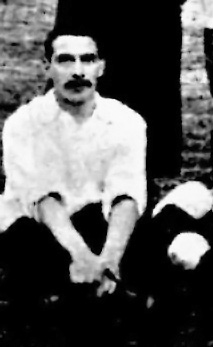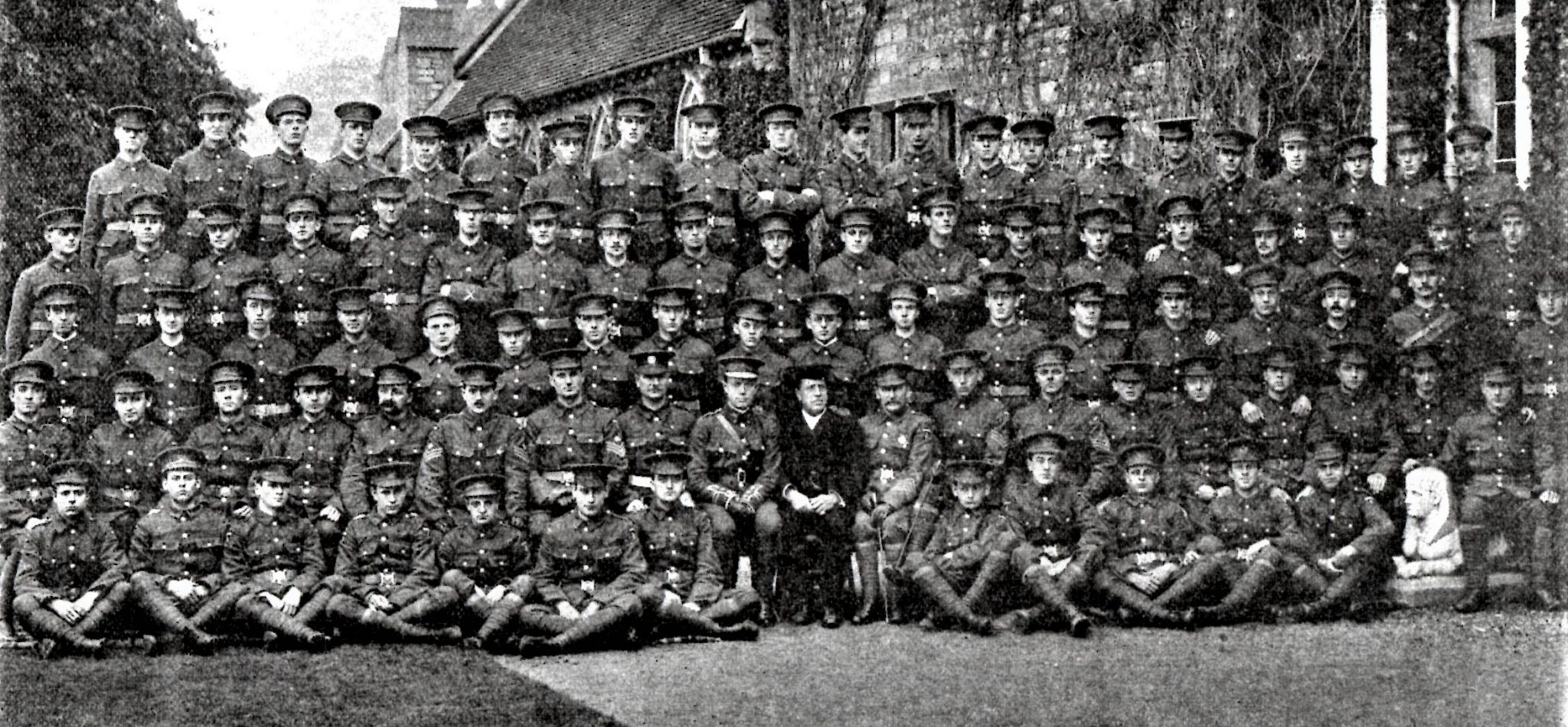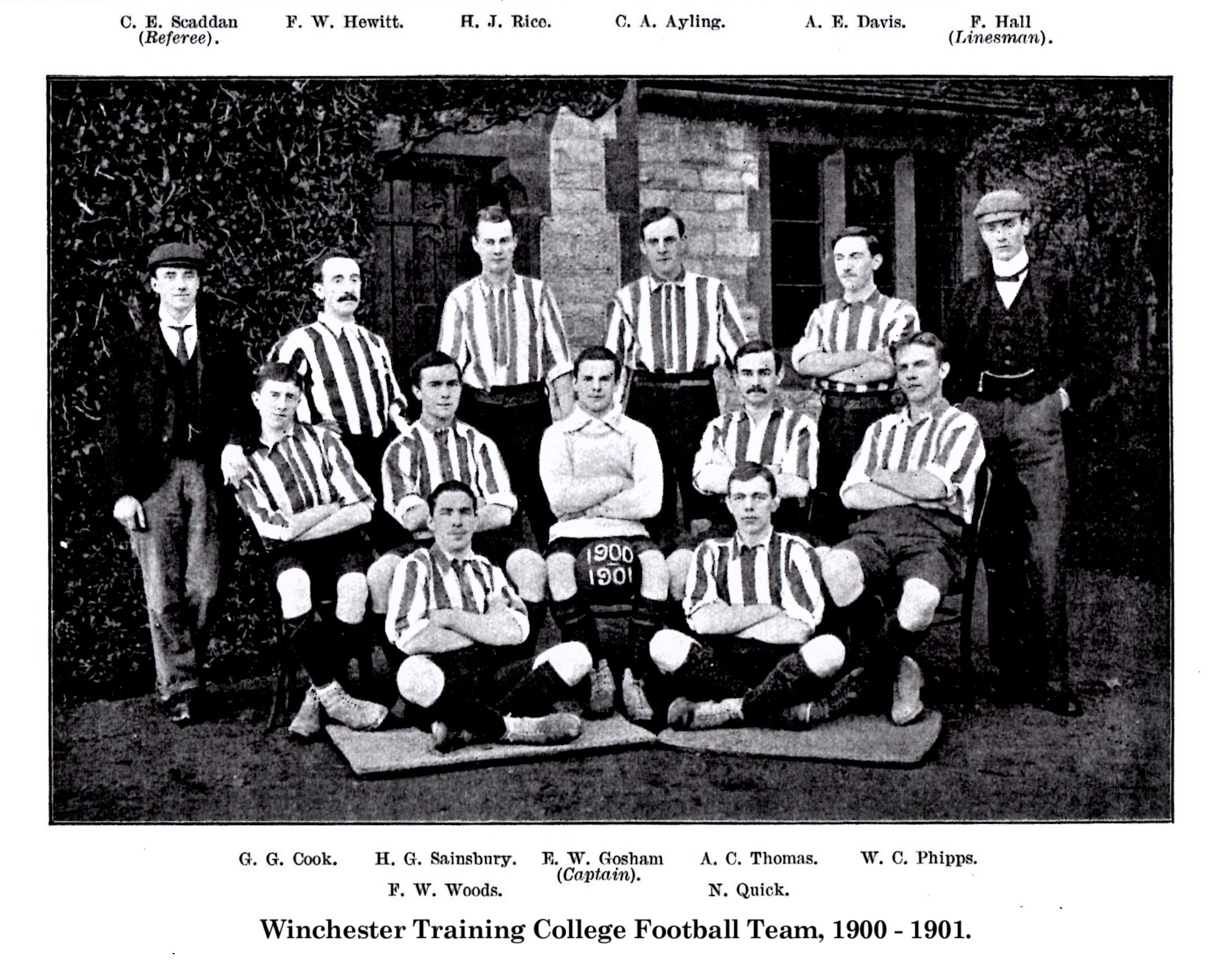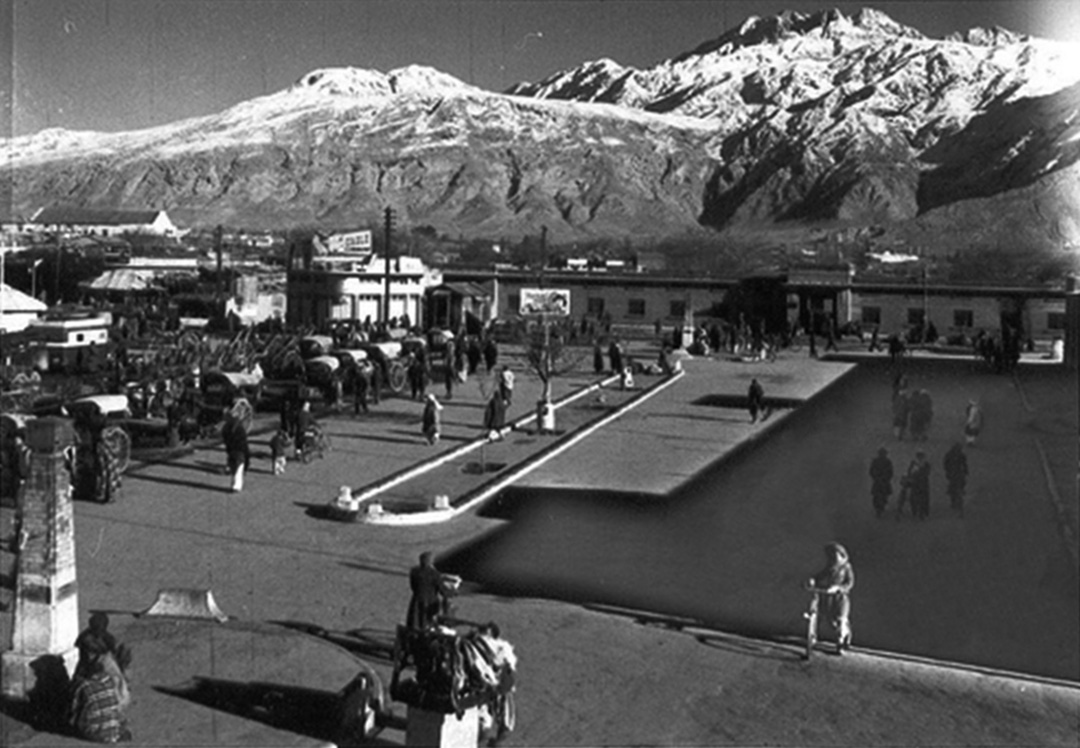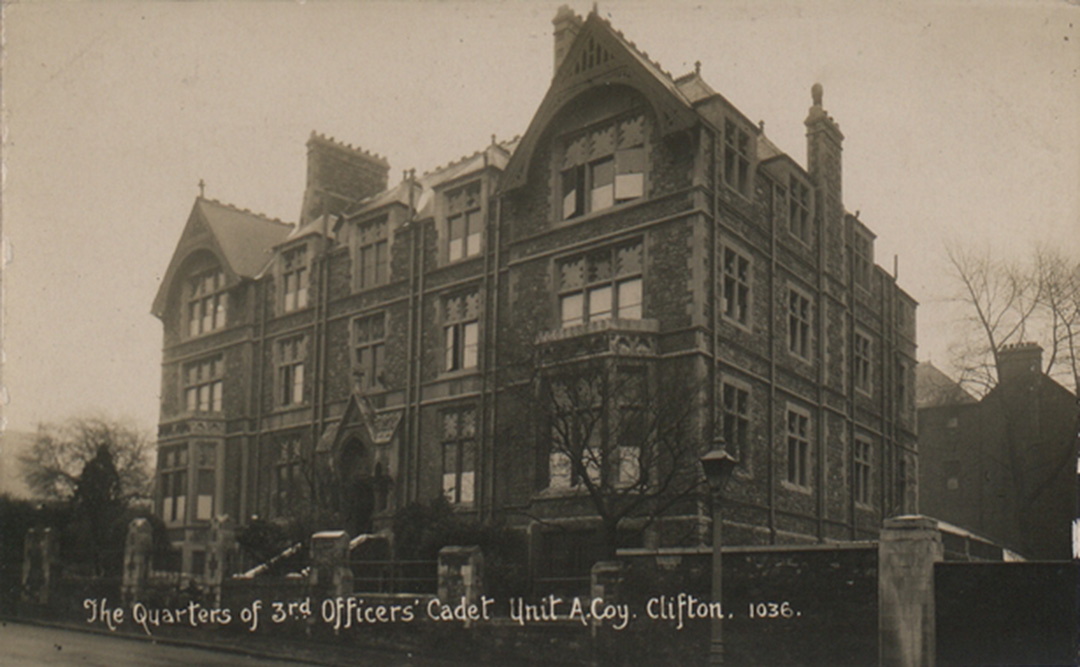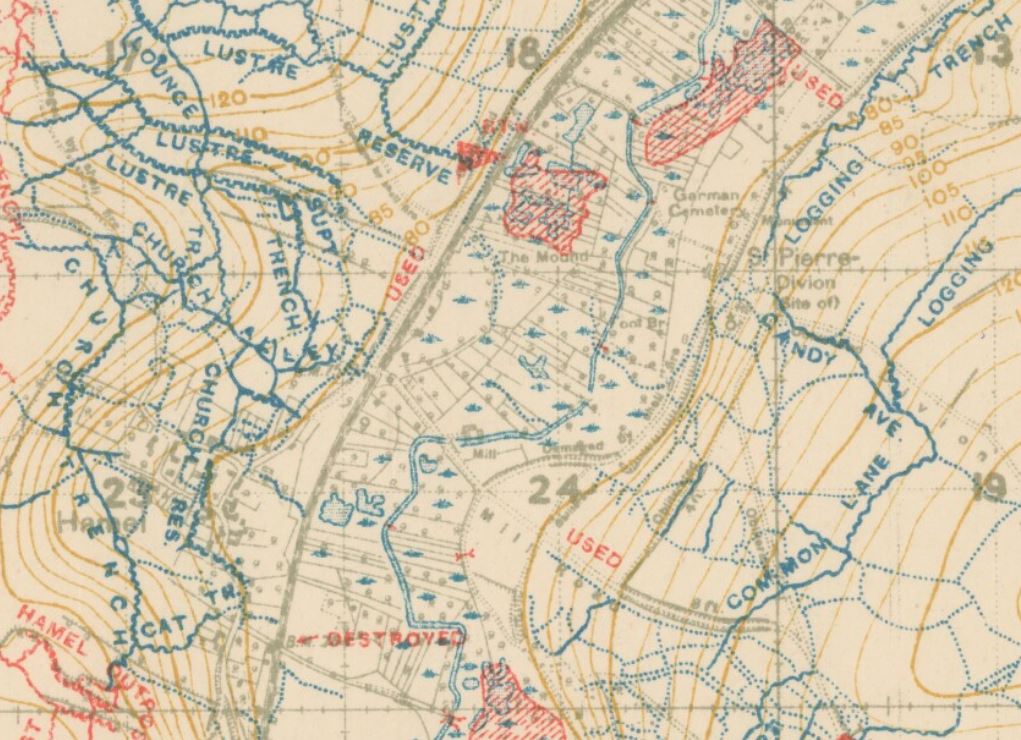
Frederick William Woods
30th November 1880”28th August 1918
Lieutenant Frederick William Woods of the 4th Battalion, Dorsetshire Regiment was killed in action on 28th August, 1918 in France.
Family and Home Life
Frederick would have known all his grandparents. His mother’s parents, William Bance Burrowes and Diana, née Brown, were both born in 1813, in Brentford and St. Martins in the Field, Middlesex. William was a school teacher,1 as was one of his sisters.2 Diana also taught and, unusually for the mid-19th Century, continued to do so throughout her childbearing years. William and Diana married on 28th February, 1839 at St Martins in the Field Church and Frederick’s mother, Rosina Maria Burrowes was the third of six children, born in St. Pancras, Middlesex, on 2nd July, 1844.
His father’s side of the family came from Wisborough Green, eight miles southwest of Horsham, Sussex. Grandfather William was a builder, born in 1805. He married Jane Saunders, born 1812, on 4th May 1836 and had eight children. Henry, Frederick’s father, was the sixth child and the youngest of their four boys. The family lived in Wisborough Green, nearby Petworth and, for a short spell, in Portsmouth. Henry grew up grew up to be a joiner until, in his late 30s, he is described as a master builder (1891) and then a builder’s manager (1901 and 1911).
Frederick was the youngest of four children born to Henry Woods and Rosina Maria Burrowes.3
William Henry, b. 1871 (died age 2 weeks)
Walter Harry Woods, b. 1873
Rosina Jane Woods, b.1879
Frederick William, b.1880
His Army record shows that he was educated at Churcher’s College, Petersfield. This is an old-foundation fee-paying school. In 1898 there were 26 boarders and 31 day-boys. Buildings included a large schoolroom, three classrooms, a dining hall, library, dormitories, a bathroom and gymnasium. In 1896 a new chemical laboratory, a workshop, and an infirmary had been added. From the original 1722 bequest, twelve scholarships were available to local boys which paid their tuition fees and gave them £20 per annum. It is not known whether William received a scholarship, nor if he were a day boy or boarder. Monies were also made available to boys towards university fees.
Frederick’s Army record begins surprisingly early. On the 7th May, 1900, he enrolled as Private No. 95 in the 3rd Volunteer Battalion Hampshire Regiment (Duke of Connaught’s Own) (I Company). The Volunteers met at the HQ at the Drill Hall, Dragon Street in Petersfield, under the commandant Captain Percy W. Seward, and drill instructor Sergeant Charles Gosling.
We have no intimation of Frederick’s chosen career until we find him at training college, preparing to teach. For this, he would have had to have taken the Queen’s Scholarship4 examination. The process was rigorous, as described by William Smoker, a student at Winchester Training College two years after Frederick:
The exam lasted from Tuesday till Friday. Two senior prefects directed us, and the College asked a modest 10/- only,5 for our board and bed. About 50 of us sat. I was one of the successful, being 9th on the list. I remember two details of that week. One was the question: Draw the position of a sheet of metal weighing one pound and suspended from one corner, when a 2 lb. weight is attached to an adjacent corner.’6
Training at Winchester Training College
1900“1902
The Volunteer Company, 1907
College meant new surroundings, new friends, and a new routine”but for Frederick there would be at least one thing familiar: the Volunteer Company. His four months of drill would mean that he was among the most experienced of all the new boys in his year’s intake.
The outstanding feature of the Company work, however, was the rendering efficient all the new recruits before the end of the Volunteer year (31st October). Each year we had some 40 students entering College about the second week in September. As soon as possible, we began putting in two drills a day, 2.00 to 3.00 and 5.00 to 6.00, until we had credited them with more than 30 drills, when we relaxed the strain.’7
In the October issue of The Wintonian, the student in-house publication, he was congratulated on gaining his stripe8 in the 3rd Hants.
The military was only a small part of student life. The academic work timetable was exacting, chapel service morning and evening, and teaching practice all had to be shoe-horned into a schedule that filled most days from first thing until lights out. Time was, however, made available for sports and some social gatherings.
We read in The Wintonian that a debate considered the advisability of professionalism in sport’. Frederick argued against the motion, the report stating that He held that it had been responsible for the frequent use of tactics of a doubtful character, and for making sport unpopular.’
Frederick Woods played football for the College first team. He also played a violin solo in a concert after the Past and Present Football match in December. He would return after leaving College to play in this fixture for the Past’ team, on Boxing Day, 1904. Old Boys’ events were not restricted to the sports field. Frederick is reported as being a member of the orchestra in a Past and Present concert.
He seems to have kept up contact not only with the College, but with the Volunteers. The Wintonian edition for 1905 to 1907 included the following: It was reported that old Wintonian Sergeant FW Woods (1900-02) shot in the team for Hampshire against the City of London, making the top score for the team.’ His skill with rifle in hand would be significant in his later military career.
On leaving College in 1902, Frederick took a position in inner-city Portsmouth: Penhale Road County School. This was a primary school in Fratton. The 1911 Hampshire Kelly’s Directory give school-roll statistics which, in the twenty-first Century, are surprising:
Penhale Road, Fratton, Landport, opened Sept. 1887, & enlarged in 1895, for 600 boys, 590 girls & 645 infants; average attendance, 646 boys, 539 girls & 438 infants; George Gill, master; Miss A. Adams, mistress; Miss E. M. Golding, infants’ mistress.
It was presumably while he taught here that he met and, in the Summer of 1907, married school teacher Ethel Annie Aldridge (née Nelder). She was the same age as he and had trained at the Diocesan Training College in Salisbury.9 On 28th April, 1909, a daughter was born to them: Phyllis Edna Woods.
In the 1911 Census, Schoolmaster Frederick was living with Ethel and one-year-old Phyllis at 97 Orchard Road, Southsea, Portsmouth. As was usual at the time, Ethel had ceased teaching to look after home and child.
Further Steps in the Army
Although his pre-College and College Volunteer service has already been covered, it is useful to see the extent and progression of Frederick’s involvement in the Volunteer Force (and, from 1908, Territorial Force):
Private No. 95 3rd Volunteer Battalion, Hampshire Regiment 7/5/1900 – 30/7/1903
Sgt No. 95 3rd Volunteer Battalion, Hampshire Regiment 31/7/1903 – 31/3/1908
Attested & posted Sgt 6th Battalion, Hampshire Regiment, 13/4/1908.10
Re-engaged Sgt 2 years 13/4/1909
Re-engaged Sgt 1 year 13/4/1911
Re-engaged Sgt 1 year 13/4/1912
Promoted Colour Sergeant 11/9/1912
Re-engaged C/Sgt 1 year 13/4/1913
Re-engaged C/Sgt 1 year 13/4/1914
Throughout this time, Frederick had been teaching in Fratton. By the time War was declared, he had been a member of the Volunteer (and the later Territorial Force) for over fourteen years. He had been awarded the Territorial Efficiency Medal, which was given on completion of twelve years of service.
Quetta, India (now Pakistan). Copyright unknown.
At the outbreak of War, Territorials were mobilised and Frederick would end up in the 4th Battalion Hampshires, brushing shoulders with many others from College, albeit mostly from more recent cohorts than his. Now as full-time soldiers, the list of appointments continued and reflects the experience and seniority built up over the years:
At the outbreak of War, Frederick was allocated to 2/4th Battalion Hampshire Regiment
Appointed acting Regimental Quartermaster Sergeant (R.Q.M.S). 26/9/1914
Quetta, India11 13/12/1914 to 21/4/1916 Serving as R.Q.M.S.
Re-designated II Class Warrant Officer12 18/9/1915
Applied from Quetta in October 1915 for a commission in the Hampshire Regiment.
Appointed to No.3 Officers Cadet Battalion at the University of Bristol 17/5/1916
3rd Officers’ Cadet Unit, Tyndalls Park, Bristol. 1916. Courtesy of Bristol Archives.
The special College War Supplement, detailing the whereabouts of alumni serving in the War, records that in June 1916 Frederick was at the 3rd Officer Cadet Unit, Bristol. The unit was in the Institution of the Deaf and Dumb, Tyndalls Park, Clifton, Bristol. He was Commissioned 2nd Lieutenant and appointed to 4th Reserve Battalion, Dorset Regiment on 15th August 1916.
While awaiting posting to an active Battalion, Frederick was injured while training with the 4th Dorsets. He was wounded in his head, thigh and leg by shrapnel from a No.5 mills bomb (hand grenade) at Ganger Common Range, Romsey, Hants on 19th September. His recovery took two months and he was passed as fit for service by a medical board on the 17th November, 1916.
Life then took an unusual direction. The expectation of a newly commissioned Officer would be to receive a posting to a unit in a theatre of war. Perhaps there were doubts about his fitness for front-line service, or it may simply be that his expertise in handling small arms had been noted. Whatever the reason, Frederick was sent across the Atlantic and appointed as a Musketry Officer in America, from November 1917 to May 1918.
America, at least nominally, entered the War on April 6th, 1917.13 The armed forces, however, were small in number,14 poorly trained, and ill-equipped. In his time there, training U.S. infantrymen, Frederick was promoted to Lieutenant on 5th February, 1918. He returned to England in May to a more active role.
Frederick was sent to the Western Front to join 6th Battalion Dorsetshire Regiment. It is difficult to know when he arrived at his new Battalion. The War Diary contains Nominal Rolls of Officers. Those drawn up at the end of May, June and July 1918 do not include his name. It is possible that he spent some time in England, re-joining his previous, or another, Service Battalion.
Firm evidence of Frederick’s whereabouts comes only in the week leading up to his death. He and the 6th Battalion were part of the 50th Brigade in France. The names of surrounding towns and villages would be familiar to any men who knew the Somme: Beaumont Hamel, Thiepval, Grandcourt, Pozières, Courcelette. Sometimes referred to as The Second Battle of the Somme, this was quite unlike the trench warfare of the First Battle in 1916: it was a hard-hitting and rapid counter-attack, pushing back the now tired, ill-supplied and depleted enemy which had spent its men and energies in the massive Spring Offensive.
The exposed nature of the Ancre and its meadows between steep banks is evident in this map of July 1918. Lustre Trench (the site of Battalion HQ) and Common Lane (Trench)15 give an idea of the crossing point. Map reproduced with the permission of the National Library of Scotland.
On the night of August 22nd/23rd, 6th Battalion’s War Diary records B Company’s part in the crossing of the river Ancre, under Frederick’s command:
Crossing the Ancre proved to be an arduous task and went to show what the Germans must have been enduring during the previous months. Nearly everybody got wet feet in the process, a fact which hampered them greatly in the continuous marching which followed.
Common Trench, which was to have been occupied by B Company was found to be held by the enemy, and a Company of the 13th Welsh attacked it that night although the position was outside their area. This overlapping caused some confusion, but on the early afternoon of the 23rd, B Company attacked the trench and cleared it with fine dash under Lieutenant Woods, obtaining prisoners and 4 machine guns all of which were sent down to 50th brigade HQ.
The advance was mostly slow and faced stiff defence. However, objectives were reached and, by the night of the 26th/27th, the Brigade arrived at the old front line from the days before the German Spring Offensive. An attack on Flers was planned and the Dorsets were assigned to the centre. The Battalion moved off at 3.30 a.m. on the 27th, with A, B and C Companies in front, and D in reserve, more or less in mass.
The old trench system north of Flers (bottom, centre). Old enemy trenches (no longer at this point necessarily occupied) are in red, allied in blue. Published December 1916. Map reproduced with the permission of the National Library of Scotland.
The Battalion crossed the front line about 3.30am and made a most dashing attack on the North End of Flers and through the ground north of it, and advanced to the ridge east of it.
The Brigade captured some two hundred prisoners. The Dorsets took ten machine-guns and three trench mortars. But both flanks of the Brigade were exposed, and a new enemy Division had come in against them. A violent counter-attack began at 7 a.m. forced the line back west of the village to the support line, only five hundred yards ahead of the starting point.16
Owing to a shortage of ammunition”of senior officers and senior NCOs”the greater part of the Battalion withdrew to the vicinity of the old enemy front line where they were reorganised by the Commanding Officer and pushed forward to conform with D Company which had been acting as a support Company and had remained in position under Lieutenant Searle. This officer kept his Company very well in hand and in good position. The best control of the attacking Companies seems to have been kept by CSM Pearce of A Company. Lieutenant Woods of B Company and 2nd Lieutenant G. Houghton were killed during the attack and 2nd Lieutenant Pawson wounded.17
The Battalion Diary is clear that Frederick died on 27th August, though all documentary sources place his death as 28th August, 1918.18 He is buried at Bulls Road Cemetery, Flers, Departement de la Somme, Picardie. To his headstone the family added these words.
A loving and devoted son, brother, husband and father. Sadly mourned.
A final melancholy footnote needs to be added to Frederick’s story. On 17th March, 1922, Frederick’s widow Ethel died, leaving 12-year-old Phyllis orphaned.19 Phyllis did not marry. She gained a BA and postgraduate Diploma of Education and taught in a Bristol secondary school. She died in Bristol in December 1916, aged 87.
Researcher and Author: John Vickers
Footnotes
[1] Census returns show that he left the teaching profession in the 1850s and became a Proprietor of Houses’ (1861) and then a Coach Beader’ (1871, 1881,1891) In this last trade, (trimming coach bodies) he had his own premises at 285 Brentford High Street in the 1870s.
[2] In the census of 1861, Frederick’s mother Rosina is shown living with her aunt in Kingston, Surrey, whose occupation is listed as schoolmistress
[3] Her baptismal record has Burrowes’, as do those of all of her siblings, and all records relating to her parents. Rosina’s Marriage and Death records record her as Burrows.
[4] This became the King’s Scholarship upon Victoria’s death in January 1901.
[5] Ten shillings: £0.50
[6] Quoted in A History of King Alfred’s College, Winchester 1840-1980 by Martial Rose, p.71
[7] The History of the Volunteer Company at the Training College Winchester edited by Capt R A Thomas. 1906-1908. Hampshire Record Office 47M91W R2/5
[8] The first stripe was that of a Lance Corporal
[9] She was recorded as a student there in the census of 1901, along with 96 other students. The College was for female students, based in King’s House in the Cathedral Close and was a sister’ college to Winchester Training College. Founded in 1841, it became the College of Sarum St. Michael in 1966. There had been very productive talks held in 1974 and 1975 to discuss a possible merger of the Winchester and Salisbury colleges, instigated by the D.E.S.. Martial Rose, then Principal at Winchester, writes of an eleventh-hour volte face, When the Salisbury governors met on 23 September, they decided unanimously not to proceed further with the merger. The result was that they received an instruction from the D.E.S. for a nil intake of students for 1976. This was virtually an instruction to close the college. The Salisbury College which had come into being in 1841 [and] so closely associated with the Winchester College might have continued in even closer association. Anxieties about property, about complying with a different validation system, about being swallowed up by a larger institution, about not having equal representative rights when management and academic issues were under discussion, were all readily understandable reasons for the withdrawal. But yet the pity of it!’ (Source: A History of King Alfred’s College, Winchester 1840-1980 by Martial Rose, p.121). This pyrrhic victory sealed the fate of the Salisbury college: closure followed in 1978.
[10] Joined at Portsmouth 13/04/1908 – Age 27 years 4 months. Trade or Calling shown as Schoolmaster for Portsmouth Educational Committee. The Territorial and Reserve Forces Act 1907 was an Act of the Parliament of the United Kingdom that reformed the auxiliary forces of the British Army by transferring existing Volunteer and Yeomanry units into a new Territorial Force (TF); and disbanding the Militia to form a new Special Reserve of the Regular Army. This reorganisation formed a major part of the Haldane Reforms, named after the creator of the Act, Richard Haldane. Practically, this meant Volunteers such as Frederick, had to enlist”hence the Attestation date of 13th April, 1908. This change also affected Frederick’s old Volunteer Company at College, which became B Company of the 4th Territorial Battalion of the Hampshire Regiment. Students from 1908 had to enlist and were subject military discipline at all times.
[11] Following the Partition of India on 15th August 1947, Quetta became part of Pakistan.
[12] Warrant Officer Class II: a new rank introduced by Army Order 70 of 1915, replacing Regimental Quartermaster Sergeant.
[13] The Declaration of War was with Germany alone. It did not initially declare war on the other Central Powers until December 7th, 1917 and even then, only on the Austro-Hungarian Empire. It did not make any declaration of war against co-belligerents allied with the Central Powers. The United States remained uninvolved in central and eastern Europe, the Middle East, the Caucasus, North Africa, Sub-Saharan Africa, Asia and the Pacific.
[14] The standing Army in 1915 was approximately 100,000. Even with the 112,000 National Guard, the U.S. troops were only 5% of the number of the German Army alone.
[15] Common Trench, which was a prolongation of Logging to the South’ (Source: History of the Dorsetshire Regiment, 1914-1919, Dudley Ward (ed.)
[16] Ibid.
[17] 40 men of Other Ranks died (Ibid.)
[18] August 28th was devoted to reorganising the Battalion.’ Although some limited action did take place, no casualties were recorded.
[19] The date of Ethel’s death is taken from her Probate record. A Legal Notice in the Portsmouth Evening News of Tuesday 04 April 1922, lists the death as 20th March 1922.
Sources
Ancestry (2018). Home page. [online] Available at: www.ancestry.co.uk [Accessed 2018].
Commonwealth War Graves Commission, (2018). Home page. [online] Available at www.cwgc.org/ [Accessed 2018].
Hampshire Record Office. The History of the Volunteer Company at the Training College Winchester (Thomas, Cpt. R.A., ed.), 47M91W R2/5. Winchester.
The National Archives. Lieutenant Frederick William WOODS. The Dorsetshire Regiment, WO374/76682. London.
National Union of Teachers. (1920). War Record 1914“1919. A Short Account of Duty and Work Accomplished During the War. London: NUT.
Rose, M. (1981). A history of King Alfred’s College, Winchester 1840-1980. London: Phillimore.
Vickers, J. University of Winchester Chapel Memorial Rail image.
Ward, D., et al. (1932). History of the Dorsetshire Regiment, 1914-1919, Dorchester: Henry Ling Ltd.
| University of Winchester Archive “ Hampshire Record Office | ||
| Reference code | Record | |
| 47M91W/ | P2/4 | The Wintonian 1899-1900 |
| 47M91W/ | P2/5 | The Wintonian 1901-1902 |
| 47M91W/ | P2/6 | The Wintonian 1903-1904 |
| 47M91W/ | P2/7 | The Wintonian 1904-1906 |
| 47M91W/ | P2/8 | The Wintonian 1905-1907 |
| 47M91W/ | P2/10 | The Wintonian 1908-1910 |
| 47M91W/ | P2/11 | The Wintonian 1910-1914 |
| 47M91W/ | P2/12 | The Wintonian 1920-1925 |
| 47M91W/ | D1/2 | The Student Register |
| 47M91W/ | S5//5/10 | Photograph of 5 alumni in Mesopotamia |
| 47M91W/ | Q3/6 | A Khaki Diary |
| 47M91W/ | B1/2 | Reports of Training College 1913-1914 |
| 47M91W/ | Q1/5 | Report and Balance Sheets 1904- 1949 |
| 47M91W/ | R2/5 | History of the Volunteers Company 1910 |
| 47M91W/ | L1/2 | College Rules 1920 |
| Hampshire Record Office archive | ||
| 71M88W/6 | List of Prisoners at Kut | |
| 55M81W/PJ1 | Managers’ Minute Book 1876-1903 | |
| All material referenced as 47M91W/ is the copyright of The University of Winchester. Permission to reproduce photographs and other material for this narrative has been agreed by the University and Hampshire Record Office. | ||

